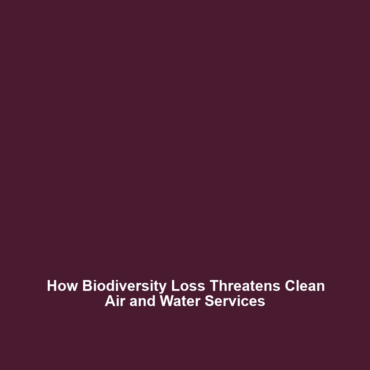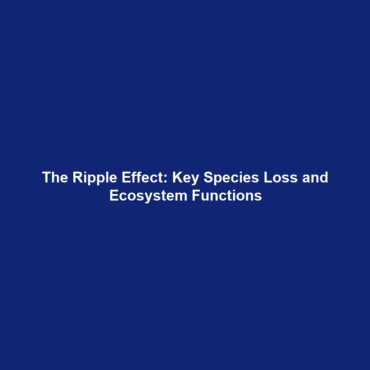The Impact of Biodiversity Loss on Ecosystem Services
Category: Deforestation & Biodiversity Loss
Topic: The loss of biodiversity diminishes ecosystems’ ability to provide essential services like clean air, water filtration, pollination, and disease regulation.
Introduction
The loss of biodiversity poses a significant threat to ecosystem services vital for human survival and environmental health. As species become extinct and habitats are destroyed, ecosystems struggle to perform essential functions such as providing clean air, filtering water, supporting pollination, and regulating diseases. This article delves into the multifaceted impact of biodiversity loss, illustrating its critical relevance within the broader context of deforestation and biodiversity loss.
Key Concepts
Biodiversity and Ecosystem Functions
Biodiversity encompasses the variety of life on Earth, including the different species, genetic variations, and ecosystems. Healthy ecosystems are characterized by rich biodiversity, which enhances their function and resilience. Key concepts include:
- Ecological Stability: Ecosystems with a multitude of species are more stable and can better recover from disturbances.
- Ecosystem Services: These include provisioning (food, water), regulating (climate regulation, disease control), supporting (nutrient cycling, habitat), and cultural services (recreation, spiritual), all of which are compromised due to biodiversity loss.
- Interconnectivity: The complex interrelationships among species and their environments mean that the loss of one species can impact many others.
Applications and Real-World Uses
Understanding the loss of biodiversity is crucial in various applications, particularly concerning environmental management and conservation. Significant real-world uses include:
- Restoration Ecology: Applying knowledge of ecosystem services to rehabilitate degraded environments, ensuring that they can continue to provide essential services.
- Sustainable Agriculture: Implementing biodiversity-friendly practices to enhance pollination and pest regulation, ultimately aiding food security.
- Urban Planning: Creating green spaces that support urban biodiversity while providing ecosystem services such as improved air quality.
Current Challenges
While the significance of biodiversity and ecosystem services is clear, challenges remain in fully understanding and managing these areas:
- Data Gaps: Incomplete data on species populations and ecosystems impedes effective conservation efforts.
- Policy Limitations: Insufficient policies and regulations to protect biodiversity in the face of industrial expansion and urban development.
- Public Awareness: Limited public awareness and engagement in biodiversity conservation efforts can undermine necessary actions.
Future Research and Innovations
Emerging research and technologies hold promise for addressing biodiversity loss and protecting ecosystem services:
- Biotechnology: Innovations in genetic sciences can aid in species conservation and restoration efforts.
- Remote Sensing: Advanced tools for monitoring biodiversity and ecosystem health from space, providing critical data for timely interventions.
- Participatory Conservation: Engaging local communities in conservation strategies to promote biodiversity-friendly practices.
Conclusion
The loss of biodiversity critically undermines the ability of ecosystems to provide essential services that sustain life and promote a healthy environment. Addressing this issue requires an integrated approach, involving research, policy, and community engagement. To combat biodiversity loss, it is essential to embrace sustainable practices and enhance conservation efforts. For further reading on the importance of biodiversity, please explore our articles on clean air and pollination services.

